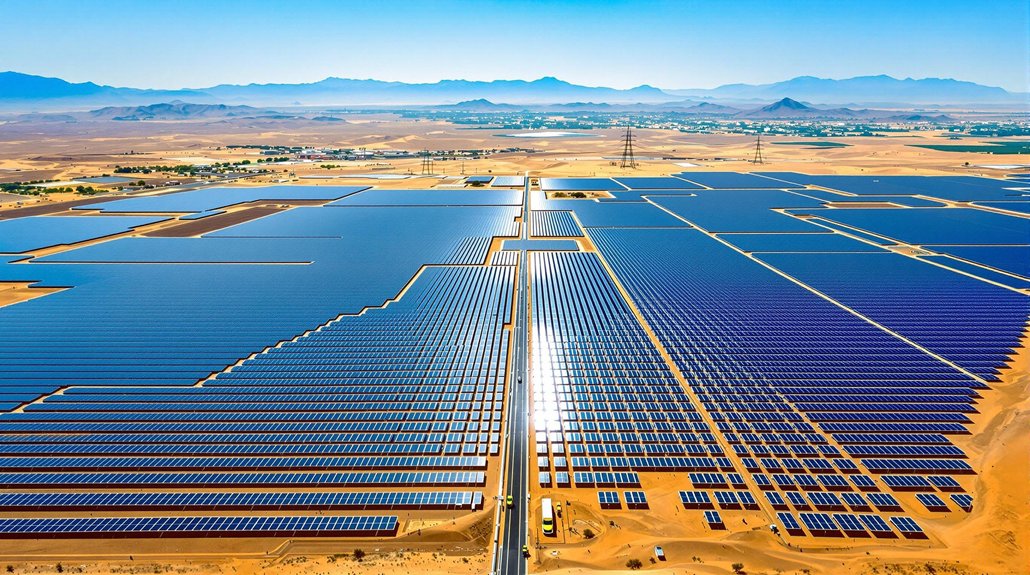Egypt’s latest 75MW solar project transforms barren desert into clean energy gold. Part of the country’s renewable transformation, it joins impressive installations like the 500MW Abydos plant already powering 300,000 homes. International partnerships with UAE’s Masdar and others are fueling this sun-powered transformation. Egypt isn’t messing around—they’re targeting 5-8% of global hydrogen markets by 2040. The desert’s finally good for something besides getting sand in your shoes. The numbers tell the real story.
Egypt is blazing a trail in solar power development. The country, known more for pyramids than panels, has suddenly become Africa’s solar powerhouse. Take the massive 500MW Abydos Solar PV Plant—one of the continent’s largest installations. It’s not just big; it’s powering 300,000 households and cutting carbon emissions by 782,300 tons yearly. Not too shabby for a desert nation.
International partnerships are driving this sunlit transformation. The UAE’s Masdar didn’t just dip a toe in; they dove headfirst by acquiring a major stake in the Benban solar complex, home to the 64.1MWp ‘Infinity 50’ project.
Meanwhile, Norwegian company Scatec inked a 25-year power purchase agreement with Egypt Aluminium for a whopping 1.1GW solar installation. That’s serious commitment.
The tech isn’t yesterday’s news either. Egypt’s first hybrid solar-plus-battery project combines 1GW of solar with 100MW of battery storage, scheduled to break ground in 2025. It’s like the country skipped the energy evolution and jumped straight to transformation.
Egypt isn’t crawling into renewables—it’s leapfrogging straight to cutting-edge energy solutions that most countries only dream about.
The battery storage—100MW/200MWh worth—will keep industrial operations humming even when the sun takes a break. These storage solutions are crucial as battery costs are anticipated to decrease by 52% by 2030, making such projects increasingly economical.
Green hydrogen is joining the party too. Abu Dhabi-listed Fertiglobe partnered with Scatec, The Sovereign Fund of Egypt, and Orascom Construction to build a green hydrogen facility in Ain Sokhna. The ambitious $4 billion project aims to produce 600,000 tons annually of green hydrogen, positioning Egypt as a leader in this emerging sector. Egypt isn’t playing small ball here.
The economic impact? Enormous. Egypt’s hydrogen strategy aims to grab 5-8% of the global tradeable hydrogen market by 2040. Their renewable targets could pump up GDP by $10-18 billion. Talk about a sunny outlook.
The government isn’t just watching from the sidelines. The Egyptian Electricity Transmission Company is signing 25-year USD-denominated PPAs, while extensive strategies guide the renewable sector’s growth.
High-level officials show up at project launches. The Benban Solar Development Complex aims for a total capacity of 2GW, developed strategically in phases to ensure sustainable growth. They’re serious about this stuff.
Egypt’s renewable ambitions aren’t just hot air. They’re happening. Right now. In the desert.
References
- https://www.pv-tech.org/masdar-takes-stake-in-landmark-benban-solar-complex-through-ib-vogt-deal/
- https://www.pv-magazine.com/2024/04/13/weekend-read-take-off-at-last-for-egyptian-pv/
- https://www.agbi.com/energy/2024/09/egypts-first-hybrid-solar-project-to-break-ground-next-year/
- https://energynews.pro/en/scatec-and-egypt-aluminium-sign-agreement-for-1-1-gw-solar-project-in-egypt/
- https://www.ameapower.com/amea-power-commissions-landmark-500mw-solar-pv-plant/








